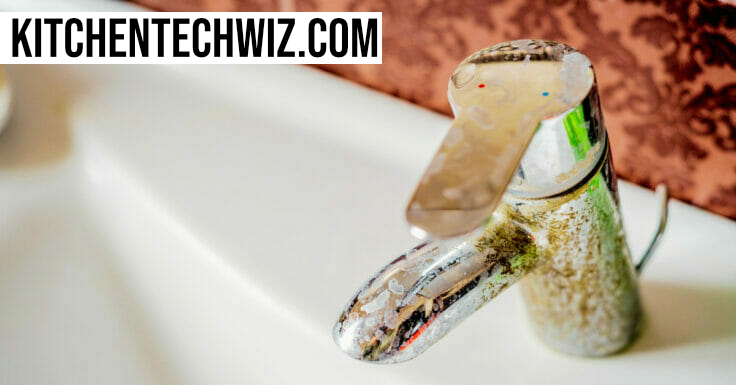If you’ve ever seen water spots on your faucet, you’re not alone. Hard water can cause mineral buildup over time that’s unsightly and can even affect the performance of your faucet. Thankfully, there are a few things you can do to remove that buildup and restore your faucet to its former glory. This article will show you how to clean hard water buildup from faucet easily. Let’s get started:
How to Remove Hard Water Buildup From Faucet
Hard water buildup on faucets can be difficult to remove and damage if you do not know the whole procedure. We will discuss 10 ways to remove hard water buildup from faucets. Here you can apply any of the 10 methods at your convenience.
1. Use vinegar
Pour white vinegar into a bag and tie it around the faucet. Let it soak for an hour. Once the faucet is completely clean, remove the bag and pour in a small bowl of vinegar (about 1/2 cup). Let it sit for 5 minutes. Rinse the faucet with warm water until it is spotless. If a scum forms, use a toothbrush to scrub the area. Allow it to dry before using.

2. Use lemon
Cut a lemon in half and rub it over the hard water buildup. The acid in the lemon will help break down the buildup to rinse it away easily. Let the lemon juice sit for a minute or two, then rinse it off with warm water.

3. Use baking soda
Baking soda is a common household item that you can use to remove hard water buildup from a faucet. It is essential to read the manufacturer’s instructions for the specific product before using it. In general, baking soda should be mixed with water to form a paste and then applied to the faucet. The paste should sit for several minutes before being rinsed off with water.
May you seeking for: Cheap kitchen faucets with sprayer
4. Use a toothbrush
It’s easy to remove hard water buildup from a faucet with a toothbrush. Just soak the toothbrush in vinegar, and scrub the buildup away. Be sure to rinse the faucet thoroughly afterwards. It is a great way to clean the gunk off of faucets without harsh chemicals.
5. Use CLR
CLR can help remove this buildup, making your faucet look new again. Pour CLR onto a cloth and wipe down the faucet. Be sure to rinse well afterwards.

6. Phosphoric acid cleaners
Remove hard water buildup from a faucet. Use a phosphoric acid cleaner. Phosphoric acid is a chemical that can dissolve the calcium and magnesium deposits that are often found in water:
- Make sure that the faucet is turned off and cool to the touch.
- Soak a cloth in the phosphoric acid cleaner and attach it to the faucet. Allow the cleaner to sit on the faucet for several hours or overnight.
- Rinse the faucet with warm water and dry it with a towel.
7. Sulfuric acid
Sulfuric acid is a great way to remove hard water buildup from faucets. They work by dissolving the calcium and magnesium that cause the buildup. You can buy this acid at most hardware stores. Read the directions carefully, as this acid can be dangerous if misused.
First, remove any attachments from the faucet to use the acid, such as aerators or screens. Next, place some of the cleaners onto a cloth or sponge, and rub it onto the affected area. Finally, rinse the area with hot water. If any residue is left behind, repeat the process until it is gone.
It’s important to note that sulfuric acid should not be used on brass or copper fixtures, as it can damage these materials. Instead, use a vinegar-based cleaner for these surfaces.
You may need: How to test hardness in water
8. Muriatic acid
Muriatic acid is a strong mineral acid that dissolves limescale and hard water deposits from fixtures and other surfaces. You can purchase it at most hardware stores, and it’s essential to read and follow the safety instructions on the label before use. According to the instructions, dilute the acid with water and pour it into a spray bottle. Spray it onto the buildup and let it sit for a few minutes. Rinse thoroughly with water. Be sure to wear gloves and eye protection when using this acid, and keep it away from children and pets.
9. Paper towels or strips of soft rags
Another easy way to remove this scale is to use a paper towel or soft rag. Wet the towel or rag and then wrap it around the faucet. Twist it tightly to create friction. Hold it in place for a few seconds, then release. Do this until the buildup is gone.
You can also use a vinegar and water solution to clean the faucet. Combine one part vinegar with three parts water in a spray bottle. Spray the solution on the tap and let it sit for a few minutes. Wipe it off with a paper towel or soft rag.
10. Rubber bands
If you have hard water, it can leave mineral deposits on your faucet. Over time, these deposits can build up, making it difficult to turn the faucet on and off. You can remove these deposits using rubber bands. Stretch a rubber band around the faucet and twist it in opposite directions. It will break up the mineral deposits and allow you to remove them with a cloth.
Also read: Hard water resistant kitchen faucets
Causes of Hard Water Buildup
Water is considered hard when it contains high levels of calcium and magnesium. These minerals can cause a buildup on fixtures, pipes and other surfaces in your home. This can lead to corrosion and decreased water flow. It can also leave a residue on dishes and skin. Several factors contribute to hard water buildup.
The most common cause is the presence of minerals in the water itself. These minerals can dissolve over time and eventually build up on surfaces in your home. Another common cause is limescale. It is a mineral deposit that forms when water evaporates. It can cause a white or brown film on fixtures and appliances. Hard water can also be caused by improper installation or maintenance of plumbing systems.
Preventing future buildup
To prevent future buildup of hard water on your faucets, consider installing a water softener system. This device works by removing the minerals that cause hard water, thus preventing them from accumulating on your fixtures. Additionally, you can use vinegar to regularly clean your faucets and remove any mineral deposits that may start to form. Simply soak a cloth in vinegar and wrap it around the affected area for a few hours before scrubbing away the buildup with a non-abrasive sponge.
Another preventive measure is to wipe down your faucets after each use to remove any lingering water droplets. This simple habit can significantly reduce the likelihood of hard water stains forming over time. Furthermore, investing in a high-quality faucet with a protective finish can also help prevent future buildup by creating a barrier between the metal surface and the mineral-laden water. By taking these proactive steps, you can effectively minimize future buildup and keep your faucets looking clean and well-maintained for years to come.
Conclusion
Water is a necessary part of our lives, but it can also be a nuisance. Hard water contains high levels of minerals, most commonly calcium and magnesium. These minerals can cause hard water buildup on faucets. When hard water minerals buildup on your faucet, it can be difficult to remove. The minerals can build up over time, making your taps and faucets look dirty and aged. This article discussed 10 ways to remove hard water buildup from faucets using everyday household items.
Maintaining a clean, residue-free faucet not only improves the aesthetic appeal of your kitchen or bathroom but also ensures the longevity of your fixtures. By following the steps outlined in this guide and using simple household ingredients like vinegar and lemon juice, you can effectively remove hard water buildup and prevent future mineral deposits. Consistently incorporating these cleaning methods into your routine will save you time and money in the long run by reducing the need for costly professional cleaning services or replacement parts.



![16 Best Tabletop Propane Gas Grills 2024: [Also Charcoal & Electric]](https://kitchentechwiz.com/wp-content/uploads/2021/04/Best-Tabletop-Propane-Grill-1.jpg)

Leave a Reply